Keyword
Seismik
107 record(s)
Provided by
Type of resources
Available actions
Topics
Keywords
Contact for the resource
Update frequencies
Service types
-
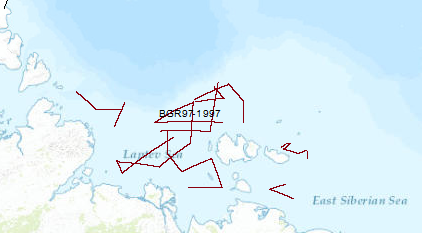
The 3rd cooperative BGR/SMNG Arctic cruise was designed to acquire new scietific data for a better understanding of temporal and spatial lithospheric variations during rifting and its influence on the tectonic and structural evolution of the continental crust of the Laptev Sea undergoing extension since at least the Early Tertiary, and for tackling open questions regarding the evolution of the submarine permafrost zone. Although conditions for seismic measurements were worse in 1997 than in 1993 and 1994, along 4,622 km of seismic traverses reflection seismic data and wide angle reflection/refraction data from 23 OBH-(ocean bottom hydrophone) stations were collected in the Laptev and East Siberian Sea. The most prominent rift basin is the Ust' Lena Rift, which is at least 300 km wide at latitude 75°N. The Cenozoic sedimentary cover exceeds 3 km everywhere, increasing up to 14 km at two locations. In the northern part of the shelf, the complex mainly N–S-trending Anisin Basin has a basin fill of up to 10 km thickness. The New Siberian Basin which is located in the northwestern part of the study area shows an up to 9 km thick graben fill. The Laptev Horst crust is locally subdivided into several tilted blocks by deep-reaching faults and there are several half grabens of smaller extent which divide the Laptev Horst into three parts: the North, the South and the East Laptev Horst. A major west dipping listric fault of at least 250 km length separates the Laptev Horst from the Ust' Lena Rift. Results from the seismological investigation indicate that recent extension is concentrated within the narrow rift basins of the eastern Laptev Sea. From wide-angle reflection/refraction seismic measurements the seismic velocities of the crustal layers were estimated along five profiles. The layers with velocities of up to 3.5 km/s apparently consist of predominantly Cenozoic sediments. The sedimentary section showing relatively high seismic velocities of 4.5 to 5.2 km/s might be interpreted as Late Paleozoic to Mesozoic deposits or overcompacted/cemented syn-rift deposits. In the eastern shelf area a layer beneath the acoustic basement was interpreted to represent Ordovician to Early Mesozoic carbonates. The lower crust in the area under study shows relatively uniform seismic velocities of about 6.0-6.8 km/s and the velocities estimated for the crust-mantle transition are in the range of 8.0 to 8.2 km/s. The origin of a several 100 m thick layer with a relative high velocity of 3 to 3.5 km/s directly beneath the seafloor was inferred as sub-sea permafrost.
-
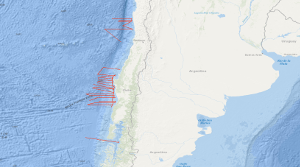
Within the frame of the comprehensive SPOC project (Subduction Processes off Chile) the SONNE cruises SO161 Leg 2 and 3 have been conducted between October 16th and November 29th, 2001, off central Chile between 28° and 44° S. In that period some 5,300 km were surveyed with multichannel seismic (MCS) reflection, magnetic, gravity, high-resolution bathymetric and echographic methods. In addition, approximately 3,900 km were surveyed with the same spectrum of methods but without MCS. The total number of 2D profiles was 48. Target was the variation of the subduction properties between the convergent oceanic Nazca and continental Southamerica plates and the different conditions that might influence the subduction process as there are: (1) age of the oceanic crust, (2) its structure and composition, (3) its sedimentary cover, (4) its thermal state, (5) the subduction angle and obliquity, and (6) the terrigenous sediment afflux from the continent. Furthermore, special focus was given to the subduction front, the subduction interface, the structure of the slope as well as to the forearc basin structure and history, and the general distribution of gas hydrate indicating bottom simulating reflectors (BSR's). The results are to be compared with previous studies of the Chilean active margin, e.g. CONDOR (SO 101 and 103) and CINCA (SO 104). The SPOC target area was subdivided into three sub-areas A,B and C. One area was chosen for a detailed survey by aid of a narrowly spaced grid and for a close link with a lot of partners. This area is characterized by a distinctly different margin type south of it is assumed. Moreover, the subducting portion of the aseismic Juan Fernandez Ridge is located in that area representing another important target of the survey. Advantageous conditions enabled the survey of an east-west profile south of Chiloé Island, providing a section through the submerged coastal Cordillera into the flooded longitudinal valley. Some results of Leg 2 and 3 are: In all areas A, B and C no subduction bulge (outer high) in the oceanic crust was visible perhaps due to the shortness of the profiles. The sedimentary cover of the oceanic crust is exceptionally thin, and the crustal thickness is generally quite "normal" with around 7 km derived from relatively weak Moho reflections. In area B a so far magnetically unmapped region was filled providing reliable ages of the oceanic crust, and suggesting that the Challenger Fracture Zone abruptly terminates west of the area of investigation. The survey in area C yielded valuable information on the trench morphology. The so far unique MCS profile south of Chiloé island shows a very wide trench and allows to extrapolate the general conditions encountered an area A southward to approximately 44° S. It can be stated that the situation is in sharp contrast to the basin structures detected by industry profiles further north in the Golfo de Corcovado.
-

The cruise leg MSM09/3 was conducted as a cooperative project between the Alfred Wegener Institute for Polar and Marine Research (AWI), the Federal Institute for Geosciences and Resources (BGR), the Geological Survey of Denmark and Greenland (GEUS) and Dalhousie University. The data format is Society of Exploration Geophysicists SEG Y. A geophysical survey covered areas of Baffin Bay and Davis Strait between Greenland and the Canadian Baffin Island. A component of the IPY 2007/08 Lead Project Plate Tectonics and Polar Gateways in the Earth System (PLATES & GATES), this project DAVIS GATE is aimed to develop a tectonic and sedimentary reconstruction of the opening process of this oceanic gateway. Baffin Bay and Davis Strait play an important role in the shallow water exchange from the Arctic to the Atlantic Ocean. The plate-tectonic evolution as well as the magmatic history of this region has been sparsely known and required a careful geophysical investigation in order to construct a set of gridded detailed paleotopographic maps for a complete geodynamic reconstruction of this gateway. With a set of three seismic refraction/wide-angle reflection profiles, using ocean-bottom seismometers on 62 stations, as well as multi-channel reflection seismic recordings with a 3000-m long streamer, data were acquired from the sedimentary cover to the deep crust and even from parts of the uppermost mantle. Additional seismic data supplement these profiles and provide insights into the structures of the basement and dominant fault zones such as the Ungava fault system. A parallel running magnetic survey aimed to resolve the temporal evolution of the oceanic crust of Baffin Bay. The extension and subsidence of the continental and transitional crust in the Davis Strait and the evolution of oceanic crust in the Labrador Sea and Baffin Bay could be investigated with dataset to which continuously recorded gravity anomaly data and sub-bottom profiler data also contribute. This dataset provides the basis of geometrical and physical properties of the crust required for a realistic geodynamic model which will describe the break-up and the ocean basin evolution between Greenland and Canada in terms of detailed paleo-topography.
-
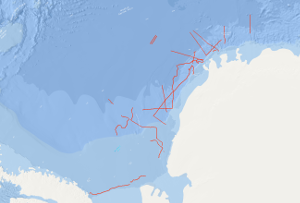
On the F.S. POLARSTERN cruise ANT-IV/3 (6th December, 1985 - 13th March, 1986) multichannel seismic measurements were carried out in parallel with magnetic and gravimetric measurements on 33 lines with a total length of 6,263 km. 3,350 km of the multichannel seismic lines have been processed aboard. The geophysical studies were designed to investigate the structure and geological development of the Weddell Sea continental margin from meridians zero to 60°W, and to define suitable and safe drilling locations for Leg 113 of the Ocean Drilling Program. The main results of the geophysical studies are: (1) The discovery of an approximately N50°E trending failed drift basin, following the trend of a negative magnetic anomaly and a positive gravity anomaly. (2) The discovery of two extensive wedge-shaped and symmetric basement units around a failed drift basin between longitudes 40°W and 20°W. The seismic characteristics, i.e. seismic velocities of 4 km/s and an internally divergent pattern of reflectors suggest that both wedges are formed from extrusive/intrusive volcanic rocks. (3) The confirmation of a major plate tectonic boundary trending approximately N80°E to N60°E, i.e. the EXPLORA-ANDENES escarpment. (4) The confirmation of a glaciogenic progradational wedge beneath the shelf of the Weddell Sea Embayment, made up of several thousand metres of sediments. (5) The definition of 13 suitable and safe drilling locations for ODP-Leg 113.
-

The structure and tectonics of the Pacific margin of Costa Rica were studied by multichannel seismic measurements in parallel with gravity measurements and swathmapping from the Cocos Ridge to Nicoya Peninsula during R/V SONNE cruise SO81 legs 1 and 2 from 18th August to 15th September 1992. In addition geological sampling has been carried out. Dominant structural feature is the buried Costa Rica Terrrane (CRT), a complex and segmented, wedge-shaped unit characterized by relative high seismic velocities of 4 km/s. The thickness of this several tens of kilometres wide zone varies between 0.5 and 3 s (twt). The CRT forms the backstop against which the sediments of the subducting Cocos plate accrete resulting in accumulation of sedimentary mass beneath and in front of the CRT, as well as in simultaneous uplift and fracturing of the CRT. It appears that the distinct CRT is affected locally by raft tectonics, i.e. a form of thin-skinned extension by normal faulting from gravity sliding over a non-stretched oceanic crust. A unit is recognizable between the base of the CRT and the surface of the subducting oceanic crust on most of the seismic lines. This unit is thought to consist mostly of ductile pelagic to hemipelagic shales. Some segment boundaries of the CRT are associated with morphological furrows, 5 to 10 km wide and up to 30 km long running across the slope. We feel that the data acquired during SONNE cruise SO81, and the preliminary results at hand have already improved our knowledge on the geological processes of active continental margins. We are convinced that plausible concepts for the origin of tsunamis and asperities can be developed on the basis of the data collected during SONNE cruises SO81 and SO76. The research of both SONNE cruises are a contribution to the International Decade of Natural Desaster Reduction (IPNDR).
-
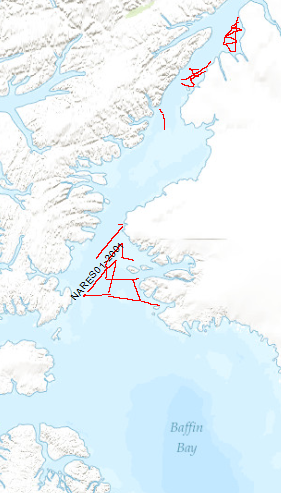
The Scientific staff and crew onboard CCGS Louis S. St. Laurent (LSL) returned September the 10th, 2001 from a scientific expedition to the Nares Strait, the northernmost waterway connecting the Arctic and Atlantic oceans. The data format is Society of Exploration Geophysicists SEG Y. The ice conditions in the strait required the support of Canada's largest ice breaker. The ship was a versatile platform for 34 scientists to accomplish their marine investigation. The LSL has a history of supporting international scientific expeditions including an oceanographic transect of the Arctic Ocean in 1994 and a biological study of the Canadian Arctic Islands in 1999. Germany (Bundesanstalt für Geowissenschaften und Rohstoffe, BGR) and Canada (Geological Survey of Canada) undertook a 5-week scientific cruise to study and explore the geological structure and evolution of the Nares Strait. The primary objective was the study of structural features relating to the formation of the Arctic Ocean and, in particular, the study of the Wegener Fault. This fault is a linear boundary between Greenland and Ellesmere Island which was noted by the German scientist Alfred Wegener in 1915 and later became the subject of a major scientific controversy. The co-operative cruise, which was planned over a period of 2 years, provided the basis for a wide range of scientific investigations, from marine seismic work and climate change studies through airborne magnetic investigations to geodetic survey measurements and geological sampling onshore. Systematic geophysical offshore studies in this key area had not been undertaken before. Where towing of seismic equipment was not possible because of ice coverage, magnetic maps were made using a helicopter-borne magnetic sensor system. Sediment and water samples taken during the cruise provide information on changes in climate and sea ice cover from the last ice-age to the present. An 11 m-long sediment core from outer Jones Sound is the longest core ever taken in the Canadian Arctic channels and holds clues to the detailed climate history of northern Baffin Bay.
-
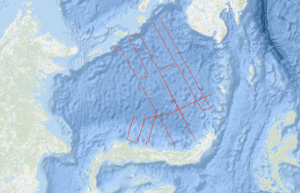
Main target of the project GIGICS (Cooperative German-Indonesian Geoscientific Investigations in the Celebes Sea) is the investigation of the internal crustal structure and the plate tectonic evolution of the Celebes Sea and its active continental margins off Mindanao and Northern Sulawesi. These investigations were carried out during the cruise SO98 of RV SONNE by the Federal Institute for Geosciences and Natural Resources (BGR), Hannover; the German Research Centre for Geosciences (GFZ), Potsdam; the GEOMAR, Kiel; the Institute of Oceanography (IfM), Hamburg; the Mines and Geoscience Bureau, Manila; the Agency for the Assessment and Application of Technology, Jakarta, and the Institute of Oceanography, Wormley. The cruise SO98 consisted of three legs of two weeks duration and one leg of four weeks duration. The total amount of data acquired during the cruise were: - 3,300 km of multichannel reflection seismics, - over 6,800 km of gravimetric and magnetic data and approximately 10.000 km of swath bathymetric and sediment echosounder data, - 3 wideangle-/refractionseismic profiles, each of 120 - 150 km length, - geological, geochemical sampling and oceanographical measurements at a total of 37 stations. During the cruise SO98 a widespaced but regular grid of magnetic and gravimetric profiles were acquired in the eastern part of the Celebes Sea from which up to then reliable data were very sparse. WEISSEL (1980) recognized in the western Celebes Sea WSW-ENE striking magnetic lineations, which he interpreted as chrons 18 - 20 (39 - 43 Ma according to the timescale of HARLAND et al. (1990)). The data from cruise SO98 show that there is no continuation of these anomalies to the east. In the eastern part the magnetic field of the Celebes Sea is less clear and much more disturbed. Nevertheless, E-W-striking anomalies are recognizable. Because amplitudes of local magnetic anomalies are higher than the lineations, the correlation of these lineations with the magnetic reversal scale is still somewhat ambiguous. The gravity map compiled from the measured gravimetric data shows elongated positive anomalies in the eastern part of the Celebes Sea. Exceptions occur at the deep sea trenches off North Sulawesi (North Sulawesi Trench) and Mindanao (Cotabatu Trench) and at the Sulu Archipelago where strong negative gravity anomalies were found. A remarkable NW-striking gravity high of up to 60 mgal was found in the central eastern part of the Celebes Sea. Gravimetric modelling suggests that this high can be correlated with the gravimetric effect of the Molucca Sea Plate subducting from the east under the Sangihe Arc. The reflection seismic data from the northern part of the Celebes Sea show indications for a juvenile subduction of oceanic Celebes Sea crust under the Sulu Archipelago. The oceanic crust bends down towards the Sulu Arc with angles between 2° and 5° and the sedimentary sequence above is deformed indicating a compressional stress regime. With the exception of two linear arranged seamount-like basement highs the Celebes Sea is dominated by two different oceanic crustal types showing distinct differences in the topography. The first one is showing a very similar reflection seismic pattern as it is found for oceanic crust of the Atlantic (HINZ et al., 1994). This type is characterized by a small-scale block-faulted relief of the top basement and a low reflectivity in lower crustal levels typically related as to be accreted at slow to intermediate spreading ridges. This type is found in the western, northern and southern part of the investigated area. In the eastern and especially in the southeastern part the igneous crust shows a very different image. The reflection of the top of the basement is less distinct and of lower frequency. The relief is very much smoother than in the previous type. This reflection seismic image indicates a volcanic/magmatic overprinting of the oceanic crust in this part of the Celebes Sea. Another target of cruise SO98 was the area of the active continental margin off North Sulawesi and its accretionary complex. The internal structure of the accretionary complex should be investigated to decide whether this active margin is also of the 'splinter-type' or not. During former geophysical cruises with RV SONNE oceanic crustal splinters were discovered in the accretionary wedges of the Sulu Sea and off Costa Rica (e.g. HINZ et al., 1991). From our reflection seismic measurements this active continental margin is morphologically subdivided into three units and consists of two accretionary complexes of different internal structural style: the lower and middle continental slope is underlain by an intensively thrusted, sedimentary accretionary wedge. This wedge was most probably formed during the last 5 Ma. Landward of this wedge an older and seismically very complex accretionary unit is present which is overlain at its landward termination by a sedimentary fore-arc basin. Within this older accretionary complex, units with a strong, low frequency reflection pattern were found which are interpreted to represent crustal splinters of igneous oceanic or ophiolitic nature. This interpretation is supported by our gravity and magnetic data. The magnetic profiles show an increase of the magnetic field towards the north arm of Sulawesi across the continental margin. This increase of the magnetic field suggests an increase of magnetized material within the older accretionary wedge towards the northern arm of Sulawesi where ophiolites are emplaced. During the interpretation of the reflection seismic data of the project GIGICS BSR's (bottom simulating reflectors) were discovered for the first time along the active continental margin of North-Sulawesi. BSR's are the seismic expression of a velocity decrease at the bottom of a gas hydrate zone. The distribution and depth of the BSR's correlates with the geochemical and geothermal results. Radiometric age dating and geochemical analyses from pillow basalts of a seamount from the southeastern Celebes Sea indicate hot-spot activity in this part of the Celebes Sea during or shortly after the formation of the oceanic crust approximately at 43 Ma ago. Three NW-striking ridges or seamount-chains in the northeastern Celebes Sea were mapped and investigated in detail. They are thought to represent a wrench fault system extending through the northeastern Celebes Sea. At the flank of one of these ridges a strongly alterated plagioclase-olivine basalt sample was dredged which was overlain by non-fossiliferous clay stone. A similar lithostratigraphic sequence was drilled during ODP leg 124 (RANGIN et al., 1990). The geochemical composition of these basalts is different from typical MORB. The existence of a large crustal splinter within the accretionary wedge off southwestern Mindanao obviously is responsible for a high thermal conductivity which in turn could have enhanced heat flow (108.1 mW/m2) and methanogenesis (405 ppb). The heat flow of 103.0 mW/m2 at the deformation front of the Mindanao wedge and the high methane concentration of 5.555 ppb suggests tectonically induced fluid transport within the wedge. High methane concentrations between 8.044 and 49.006 ppb at the lower slope off Sulawesi and in the North Sulawesi Trench are accompanied by high heat flow values of up to 100.5 mW/m2. Heat flow is significantly lower upslope (31.3 mW/m2). This general heat flow distribution pattern is seen over a large portion of the accretionary wedge. The elevated heat flow values and high methane concentrations near the deformation front most likely result from heat transport by fluids squeezed out from vertically and laterally compacting sediments. The reduced heat flow towards the coast is compatible either with a cooling effect of slow subduction of the oceanic crust, or stacking of cool slabs of compacted sediments. A subduction of oceanic crust with a heat flow around 60 mW/m2 over a period of more than 3 million years would have produced the low heat flow values of the upper slope if the wedge consists of claystone with a low thermal conductivity (1.2 - 1.7 W/mK). Even in the low-heat flow area isolated fluid venting is possible. Lateral variations in the heat flow pattern (e.g. broadening of the anomalies in the west) may be due to different thermal regimes within the subducted crust.
-
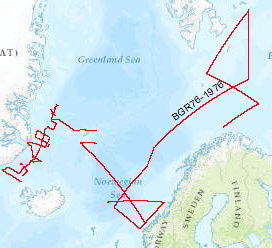
On the MS Explora (1st September, 1976 - 29th September, 1976) multichannel seismic measurements were carried out on 44 lines The area covered was the Barentssea. The data format is Society of Exploration Geophysicists SEG Y.
-
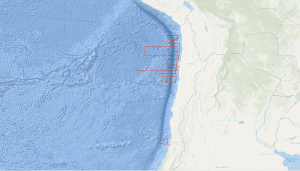
The CINCA marine geoscience investigations on the convergent continental margin of Chile between 19°S and 33°30'S were accomplished during three legs of RV SONNE cruise SO-104, from 22. July to 15. October 1995. The objectives of the first leg are to contribute to an understanding of the geological architecture and of the tectonic mechanism in the area of the Chile convergent zone through a geophysical assessment of the tectonic structures of the Chile continental margin and the adjacent oceanic Nazca plate. During the first leg from 22. July to 24. August 1995 multichannel seismic reflection data with BGR's new digital streamer were collected along a systematic grid with a total traverse length of 4,494 km simultaneously with the acquisition of magnetic, gravimetric, Hydrosweep and Parasound data over a total traverse length of 7,012 km. GFZ's mobile land array of 12 seismic stations recorded the air gun shots fired by RV SONNE within the CINCA area. Three seismic lines were surveyed between 32°30'S and 33°30'S in the area of the CONDOR project. Here, the surface of the downbending oceanic crust is smooth. The 5,000 m to 6,000 m deep trench floor is underlain by sediments, in excess 2,500 m thick. The inner trench slope consists of a landward thickening accretionary wedge which terminates against a body forming the base of a fore arc basin near Valparaiso. The principal area of the CINCA project extends between 19°S and 26°S and comprises the convergent continental margin, the Peru-Chile trench and the seaward adjacent part of the Nazca plate up to approximately 75°W longitude. The tectonic regime of these units of the CINCA area is very different from the tectonic system of the respective units of the CONDOR area. The Eocene-aged and sediment-starved oceanic crust of the Nazca plate becomes blockfaulted when approaching the outer trench slope break. The 50 km to 70 km wide outer trench slope is characterized by a complex system of horst and graben structures in the CINCA area probably resulting from the strong downbending. Steep fault scarps forming the flanks of the horsts reach vertical offsets varying between few hundreds of metres to 1,000 m, and locally even more. The 7,000 m to 8,l00 m deep trench is very narrow and mostly sediment-starved in the CINCA area. Morphology and architecture of the continental margin of the CINCA area are controlled by planar and listric faulting and tilted blocks of inferred continental nature, which apparently slid down into the trench. The inferred continental blocks, overlying a reflective mass, are covered by sediments of presumably turbiditic nature. An accretionary wedge is difficult to define on the seismic single channel records from the CINCA area. However, processed seismic data show a deep reflective mass underlying the downfaulted blocks of inferred continental nature. This deep reflective mass is interpreted to consist of a tectonically eroded and underplated continental crust-basalt melange forming the transition between the downfaulted continental upper plate and the subducting oceanic lower plate. Complex structural highs of still unknown origin and nature have been observed on the upper continental slope at 20°S, 24°S and 25°S. The northernmost structural high represents the seaward termination of the Iquique fore arc basin. The accuracy of the acquired gravity and bathymetric data is very good, i.e. better than 1 mGal and less than 10 m. The Chile trench is associated with strong negative gravity anomalies, and the continental margin is characterized by several positive and negative gravity anomalies of varying size and amount. The first results of magnetic modeling show, that the intensive blockfaulting of the oceanic crust across the outer trench slope causes no loss of the magnetization of the oceanic crust. The air gun shots fired by RV SONNE in 50 m intervals along 17 seismic traverses were recorded by GFZ's mobile land array in the coastal area of Chile. Good quality data were obtained out to about 100 km distance and in some cases even out to about 150 km.
-
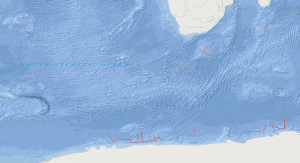
The BGR Antarctic cruise 1996 from 29th December 1995 to 6th February 1996 with M.S. AKADEMIK NEMCHINOV was designed to acquire new marine geophysical data for a better understanding of the geological processes, timing, occurrence and location of rifts of the initial break-up of southern Gondwanaland. A total of 3,836 km of multichannel seismic reflection data have been collected in the areas of the Cosmonaut Sea, the Astrid Ridge, the Lazarev Sea and the southern Agulhas Plateau in parallel with magnetic and gravity measurements. In addition magnetic and gravity measurements were carried out on transit. Major new observations of the collected MCS data include: (1) Volcanic rocks play a major part in the construction of the Astrid Ridge and also of the Agulhas Plateau. (2) The early opening of the Lazarev Sea was associated with excessive volcanism resulting in the emplacement of a voluminous volcanic body characterized by an internally divergent pattern of seaward-dipping reflectors. (3) The Astrid Fracture Zone continues in form of a sediment-filled basement depression flanked by distinct basement highs into the Lazarev Sea, and apparently swings to the west parallel to the coast of Queen Maud Land. (4) The thickness of sediments in the Cosmonaut Sea overlying oceanic crust of inferred Early Cretaceous age is in excess of 4s (twt), i.e. about 6,000 m. Three regional seismic markers of inferred Cretaceous, Late Eocene-Oligocene and Middle Miocene ages subdivide the sedimentary column.
 www.geodatenkatalog.de (S1L)
www.geodatenkatalog.de (S1L)